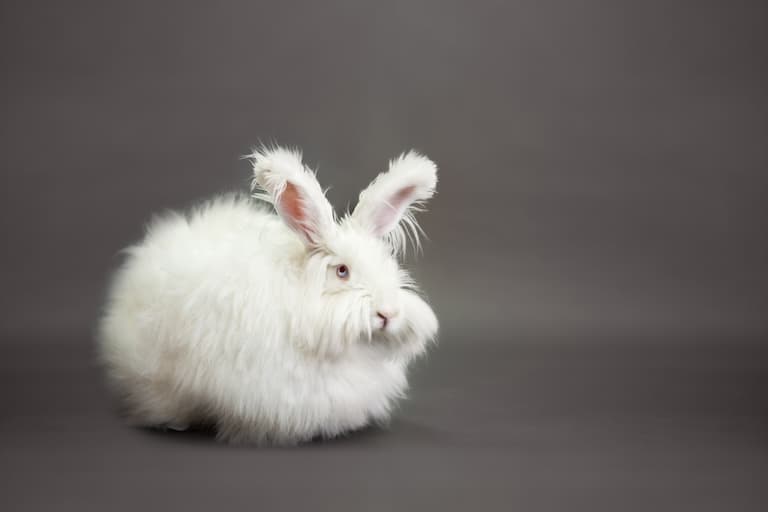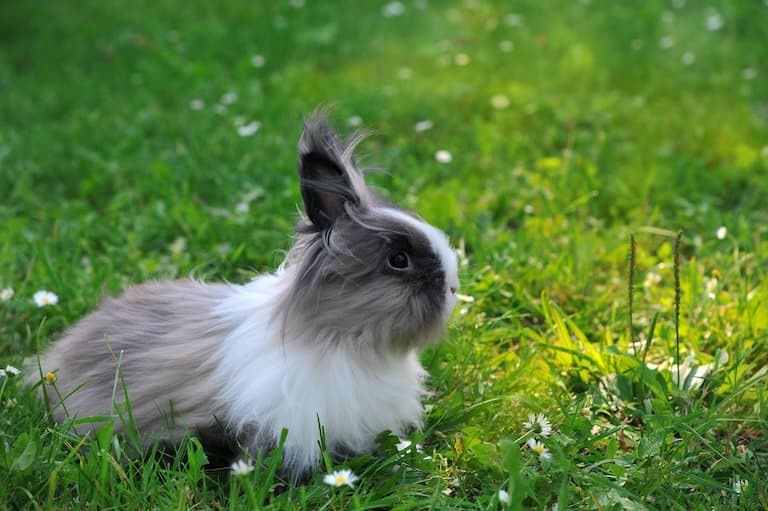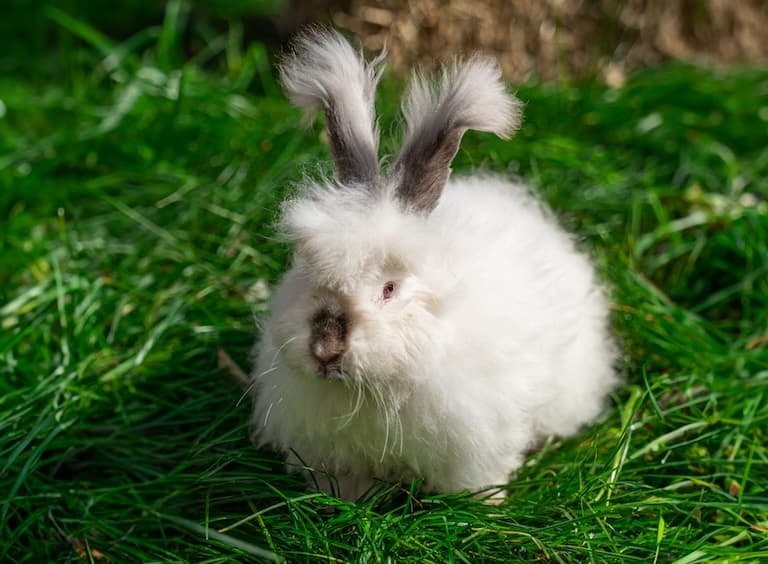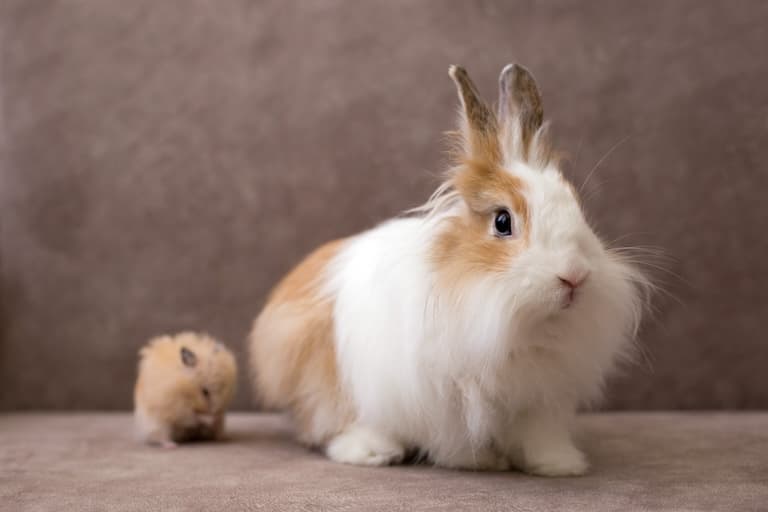Angora Rabbit Profile
There’s a worrying amount of overlap between neglectful, superficial animal owners and people who are predominantly interested in how fluffy an animal is.
Unfortunately, this means the fluffiest of creatures are often the most exposed to the Elmyra Duff treatment. Rabbits are a good example, and of all rabbits, perhaps the Angora rabbit is the fluffiest.
Unfortunately, these ones are so fluffy that their abuse isn’t limited to the suffocating love of an overbearing child but is outsourced to industrial fur farms, as well.

Angora Rabbit Facts Overview
| Habitat: | Domesticated |
| Location: | Global, primarily in North America, Europe, and Asia |
| Lifespan: | 7–12 years |
| Size: | 30–50 cm (12–20 inches) |
| Weight: | 5.5 kg (12.5 lb) |
| Colour: | Varied: white, black, grey, fawn, chocolate, or others |
| Diet: | Wool-producing breeds may require extra protein. |
| Predators: | Humans |
| Top Speed: | Not measured |
| No. of Species: | 1 |
| Conservation Status: | Not listed |
Angora rabbits are one of the oldest breeds of domesticated rabbits, which are considered a subspecies of the European rabbit.
This breed comes about from the demand for soft and insulating fur for human clothing – something which was a lot more justifiable at the time, before the invention of synthetic materials.
Sadly, they’re still bred for this purpose, and the process of harvesting them appears to have become no less medieval than it was when it started.
Interesting Angora Rabbit Facts
1. They’re domestic rabbits
The European rabbit is one of the most recognisable animals on the continent (and, unfortunately for Australians, some
other continents too). These rodent-like animals are members of a sister taxon to Rodentia called Lagomorpha, and share it with the hares and pikas.
Rabbits span the range of human preferences from pests to pets and were said to have been domesticated for thousands of years, originally by French monks around 1400 years ago as a substitute for meat. This story is as fallacious as the logic behind it, though the timing checks out.
Over the centuries, they have been bred into a variety of flavours, the Angora being one of them. This fluffball is a large breed, sometimes weighing more than five kilos, much heavier than the 2 kg wild variety.

2. They might be really old
The domestication of rabbits is not well understood, which is why there are magic monk myths that are commonly cited in place of real evidence.
Angoras were domesticated by the 1700s, because the French royalty imported them around this time to have as fashion accessories, but their domestication, thought to have begun in Turkey, may date back much farther.
Angora is more than just a breed of rabbit, it’s the old name for Ankara, and the region of Turkey where all those Angora goats come from, but there are seemingly unsupported claims that the breed dates back to the Romans, and to as far back as 100BC.
Given the inaccuracy of contemporary claims around rabbit domestication though, this information is as trustworthy as a French monk.
Still, we know more about what’s happened since the 1700s, which includes the development of the breeds currently recognised.
3. There are at least four kinds
Various uncited claims put the varieties of Angora rabbits at between 4 and 13. The low end reflects what the American Rabbit Breeder’s Association have written down, so it’s a good place to start.
These four are the English Angora, the French Angora, the Satin Angora and the Giant Angora.
The English and French breeds are show and pet breeds respectively, the Satin is a step up from the English, and the Giant was bred to maximise fur production. And they do that very well.
4. They have a lot of fur
The largest Angora rabbits can produce almost 2 kg of wool every year. They have dense, soft and woolly fur and this thick coat is one of the most common reasons the breed is kept.
It comes in a variety of colours, from black, through fawn to white, and while it can be quite a status symbol if you’re the last queen of France, it’s more commonly prized as a source of wool.

5. They make good wool
Angora rabbits, like most domesticated sheep, have been bred to grow their hairs non-stop. This results in an unworkable ball of dreadlocks that would ultimately kill the animal if it’s not maintained, and this is where shearing the animal comes in handy.
Angora fur can be worked into a very popular wool and can trigger fewer allergies than other firs, but industrial interests are at odds with the interests of the rabbit, so shearing is replaced by plucking, which maintains longer hairs to work with at the cost of tremendous pain and fear to the rabbit.
Many sources will say that the process doesn’t harm the rabbits, and this is one of those rare instances where both evidence and common sense suggest that corporations might just be making stuff up to sell more products.
China is the biggest exporter of Angora wool, but there are other culprits, commonly known for cruel cage systems and altogether miserable conditions for the animals.
Unfortunately, this breed often doesn’t fare better as a pet. 1 2
6. They make high-maintenance pets
Hopefully, much like the state of gun ownership in the US, the world will look back on these as the dark ages of consumerism and wonder how the hell people were allowed to just walk into a shop and buy an animal to take home.
Unfortunately, the stark lack of regulation around pet ownership means that impulsive people with money all over the world (except Australia and some other islands) can take an Angora rabbit home with them and mistreat it.
Their fluffy nature is appealing to many, but the reality is that these are not good pets for beginners, and even the breed itself isn’t a particularly healthy one. They are prone to various disorders and diseases, and their fur takes constant maintenance to keep them comfortable.
They have higher protein requirements in their diets but can develop kidney stones if fed too much alfalfa, which is a common protein source for livestock.
So, despite being regarded as gentle and sociable animals, these are not ideal pets for people who want a low-maintenance novelty accessory. A much better suggestion would be a plushy toy rabbit, made from synthetic materials with no hole to poo out of. 3

Angora Rabbit Fact-File Summary
Scientific Classification
| Kingdom: | Animalia |
| Phylum: | Chordata |
| Class: | Mammalia |
| Order: | Lagomorpha |
| Family: | Leporidae |
| Genus: | Oryctolagus |
| Species: | cuniculus |
Fact Sources & References
- “Angora”, Four Paws.
- (2024), “7 Reasons Never To Wear Angora”, Plantbased Treaty.
- Aleatha, “Raising Angora Rabbits: My Best Tips and Supplies”, Spindle and Spoon Homestead.
